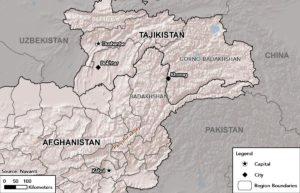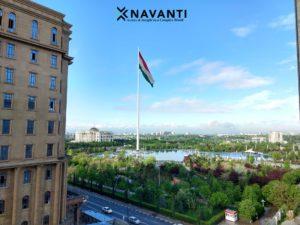Tajik-Afghan Tensions and Dushanbe’s Concerns about the Taliban by Phillip Yonge
 The US withdrawal from Afghanistan created a power vacuum which was rapidly exploited by the Taliban and its affiliated groups. Afghanistan’s use as a base for violent extremism organizations (VEOs) under the Taliban in the 1990’s has regional actors worried about modern-day Afghanistan becoming a catalyst for regional instability.
The US withdrawal from Afghanistan created a power vacuum which was rapidly exploited by the Taliban and its affiliated groups. Afghanistan’s use as a base for violent extremism organizations (VEOs) under the Taliban in the 1990’s has regional actors worried about modern-day Afghanistan becoming a catalyst for regional instability.
Tajikistan, who shares an 843-mile border with Afghanistan, is the most concerned actor in the greater Central Asia region. Unlike other Central Asian countries such as Turkmenistan and Kyrgyzstan, who have actively cooperated with the Taliban, Tajikistan has consistently increased its rhetoric against the Taliban over the past month. In August 2021, Tajikistan’s President, Emomali Rahmon, went on record saying Tajikistan would only cooperate with the Taliban if the government it formed in Kabul was ‘inclusive’, signaling his desire for Afghanistan’s ethnic Tajik minority to be represented in any future politics in the country. Ethnic Tajiks makeup more than one-quarter of Afghanistan’s 38 million people. Additionally, Rahmon addressed the United Nations General Assembly on September 23rd and stated the recent developments in Afghanistan were “a serious threat to regional security and stability.” Today, the tensions between Afghanistan’s new Taliban-led government and Tajikistan are at the highest level in 20 years and stem from the threat of regional instability; however, recent developments have increased Tajikistan’s interest in combatting the Taliban’s rule over Afghanistan.
 As the Taliban swept through Afghanistan, many members of the Ghani regime as well as former Afghan national military personnel fled to Tajikistan. Dushanbe gave many of these officials protection, including Amrullah Saleh (Ghani’s former vice president) and Abdul Latif Pedram (leader of National Congress Party of Afghanistan) as well as many US-trained pilots who fled in planes to Bokhtar as the Taliban closed on Kabul. Importantly, the Tajik government has also given support and refuge to Ahmad Massoud, the leader of the National Resistance Front (NRF). From the Panjshir Valley, located 150 kilometers northwest of Kabul, the NRF has continued to fight as the one of the last organized resistance movements to the Taliban. The Panjshir Valley is also home to the largest population of ethnic Tajiks in Afghanistan. Dushanbe’s ongoing sheltering of former Ghani officials as well as its outright support for the NRF has infurated Taliban leadership, who claim Tajikistan is interfering in its sovereign affairs.
As the Taliban swept through Afghanistan, many members of the Ghani regime as well as former Afghan national military personnel fled to Tajikistan. Dushanbe gave many of these officials protection, including Amrullah Saleh (Ghani’s former vice president) and Abdul Latif Pedram (leader of National Congress Party of Afghanistan) as well as many US-trained pilots who fled in planes to Bokhtar as the Taliban closed on Kabul. Importantly, the Tajik government has also given support and refuge to Ahmad Massoud, the leader of the National Resistance Front (NRF). From the Panjshir Valley, located 150 kilometers northwest of Kabul, the NRF has continued to fight as the one of the last organized resistance movements to the Taliban. The Panjshir Valley is also home to the largest population of ethnic Tajiks in Afghanistan. Dushanbe’s ongoing sheltering of former Ghani officials as well as its outright support for the NRF has infurated Taliban leadership, who claim Tajikistan is interfering in its sovereign affairs.
Tajikistan’s interests in Afghanistan are more complex than merely ensuring regional security, as many Tajik nationals are documented or rumored to be fighting with extremist groups in Afghanistan. In late July 2021, it was reported that a notorious Tajik militant commander named Mohammad Sharifov (also known by his alias, Madhi Arsalon) had been appointed head of security for five districts in Afghanistan’s far-northern Badakhshan province. Sharifov’s appointment followed his departure from Tajikistan to meet with Taliban leadership. Dushanbe is particularly concerned about this development given the proximity of the volatile Gorno-Badakhshan Autonomous Oblast (GBAO) to districts controlled by Sharifov’s forces.
Making up around 45% of Tajikstan’s territory yet home to only 220,000 of Tajikistan’s some 9 million citizens (2.4%), GBAO has proven to be a thorn in Dushanbe’s side since the country gained its independence in 1991. This region, which is largely isolated from the rest of Tajikistan due to its mountainous terrain, is culturally different than other parts of Tajikistan with communities in remote valleys speaking Pamiri languages such as Shugnani, Rushani, Yazgulomi, Ishkashimi, and Sariquli. During the Tajikistani Civil War (1992-1997), the Pamiri nationalist party Lali Badakshan joined with other opposition forces to fight Dushanbe’s influence in GBAO. Although the forces under Rahmon and his allies eventually gained power throughout Tajikistan, greater autonomy for GBAO remains a popular sentiment. Today, GBAO’s affairs are dominated by a number of power brokers, known locally as ‘the Authorities’, who hold considerably more regional clout than most government officials. With this area of notable unrest and anti-government sentiment so close to a volatile Tajik extremist leader in Afghanistan backed by the Taliban, government officials in Dushanbe have taken notice of potential threats emanating from the Afghan border provinces.
As of October 4th, the situation on the Tajik-Afghan border was escalating significantly. On September 30th, Tajikistan held joint-military drills with Russian troops from the 201st Military Brigade that simulated an “unlawful armed formation moving along a mountain serpentine towards a village” along the border of Tajikistan and Afghanistan. This came after the deputy head of the Taliban, Abdul Ghani Baradar, stated it would not tolerate Tajikistan’s meddling in Afghan affairs. Additionally, the Taliban have reportedly deployed a battalion of suicide bombers, the Lashkar-e-Mansoori battalion, to the border provinces with Tajikistan. Also on September 30th, Emomali Rahmon oversaw a military parade in Khorog, the capital of GBAO, where he called on the national army to “continue to protect the peace and stability of their native land.” That Rahmon’s regime and Tajikistan’s Russian allies have heightened their security presence along the border with Afghanistan signals Tajikistan will continue to support opposition against the Taliban in Afghanistan.
While it is unlikely the saber-rattling between Tajikistan and Afghanistan’s Taliban leadership will devolve to full-scale war, the potential for a protracted, tit-for-tat conflict remains high. Taliban leaders are aware of Russia’s backing of the government in Dushanbe and remain fraught with domestic problems, including the ongoing opposition of the NRF and suicide bombings from ISIS-K and other divergent VEOs. For its part, Tajikistan can likely ill-afford a costly conflict with Afghanistan, as the Rahmon regime has domestic problems of its own. All told, the immediate threat to Tajik interests of the Taliban’s takeover remains the risks of radicalization of Tajikistan’s citizens and the possibility of Taliban persecution of the ethnic Tajik minority within Afghanistan.

